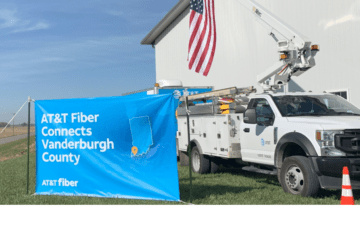A few months ago, ahead of the NTIA’s Broadband Equity, Access & Deployment (BEAD) Program state funding announcements, I shared some of the progress we had made in deploying high-speed fiber internet to more Americans through the power of the public-private partnership model. Now, as states gear up to submit their initial proposals for BEAD, it’s critical we understand what it will take to ensure successful deployment – from start to finish.
In August, I had the opportunity to attend the National Conference of State Legislatures’ (NCSL) Annual Legislative Summit in Indianapolis, Indiana. Surrounded by state legislators, industry leaders, and local stakeholders, it was clear that above all, teamwork will be essential throughout the entire deployment process as we work together to bridge the digital divide.
As part of the events during the Summit, I joined a group of colleagues and stakeholders at the recently opened AT&T Connected Learning® in Indianapolis. While there, I had the chance to share what I believe are the most important considerations for ensuring the public and private sectors are in lock step as we make use of these unprecedented funds. Thinking back on the competitive processes I’ve seen thus far, the ones with the best outcomes prioritized flexibility and had an eye to the future.
State programs should allow flexibility for providers to design projects that reach BOTH unserved and underserved locations to maximize efficient deployments reaching more people.
If you think about a house, you wouldn’t first build a kitchen and then come back later to finish the rest of the house. If we apply this same concept to deploying fiber networks, we see how much more effective it becomes when we’re able to build to both unserved and underserved locations at the same time, covering an entire area with critical fiber infrastructure with one build.
We also know providers are best positioned to design their own project areas because, simply put, they know how best to build their own networks. But we know that this won’t be possible in every state. The next best alternative is for states to group eligible locations into the smallest geographic unit possible, such as a Census Block, and allow providers to combine these Census Blocks into project areas. However, Census Blocks can still be relatively large in rural areas, so in these instances, states should modify the project area boundaries as appropriate for efficient deployments.
Ultimately, we encourage states to define project areas in a way that will lead to more participation, and in turn net less costly deployments with more choices and more Americans connected more quickly.
To hear more about the importance of flexibility and the power and future-proofing capabilities of fiber technology, check out this clip below from the NCSL Summit.
More Smart Policy for Broadband Deployment
With an unprecedented amount of federal dollars available to connect millions of more Americans to high-speed broadband, providers have an opportunity unlike any other. But for providers to maximize these once-in-a-generation funds, it’s important not to overcomplicate and overregulate the deployment process – because Americans are relying on us to get connected.
Here a few additional considerations for states as they are drafting their initial proposals:
- Rate regulation decreases participation. Providers and the government are already on the same page and prioritizing offering low-cost plans for these projects to increase affordable solutions. Any further price-capping measures would be counterproductive to our goal of reaching more Americans with broadband. To increase competition and give states the option to choose the provider that best suits their needs, it’s important to avoid rate regulation.
- Permitting requirements can lead to deployment issues. Permitting requirements that differ across municipalities can be burdensome to providers deploying broadband. These requirements can lead to delays and increase project costs, meaning more tax dollars spent and more Americans waiting longer for a reliable internet connection. The last thing anyone wants is to miss out on high-speed connections in their community because of permitting obstacles.
- Taxing broadband means fewer Americans get connected. Taxing BEAD funding is like having one foot on the gas and one foot on the brakes – with this historic opportunity, we need to stay focused on the finish line. To connect as many people as possible, it’s critical investments in broadband go directly toward deploying broadband and creating connections.
I was thrilled to join industry leaders and policymakers to discuss these considerations, among others, at USTelecom’s 2023 Broadband Investment Forum earlier today.
It’s exciting to see how many more Americans we’ve already been able to connect to fast and reliable internet service, but the best is yet to come. By keeping in mind smart policy throughout the deployment process, we’re on track to maximize this unprecedented amount of federal dollars and open the door to greater possibility for Americans across the country.





